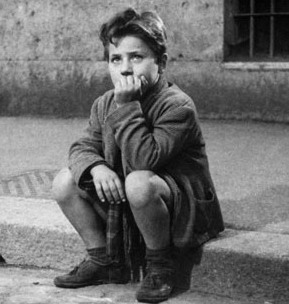Child star of neorealist classic Bicycle Thieves
 |
| Director Vittorio De Sica was struck by Enzo Staiola's naturally expressive eyes |
Staiola’s character in Vittorio De Sica’s 1948 film was Bruno Ricci, the eldest child in a working class Roman family desperately trying to survive in the hard economic climate that followed the end of the Second World War.
The central character in the film is Bruno’s father, Antonio, who lands a job posting advertising bills around the city but is required to have a bicycle to transport himself, his ladder and bucket to wherever his services are required.
Antonio buys a bicycle after pawning some of the family’s few possessions of value only to have it stolen on his first day at work. The remainder of the film follows Antonio and Bruno as they try to find the bicycle.
The essence of the neorealist genre was that directors achieved authenticity by eschewing the use of professional actors in favour of ordinary people who lived in the city or neighbourhood where the action was set.
De Sica chose Lamberto Maggiorani, a steel factory worker, to play the part of Antonio, turning down the chance to employ established Hollywood star Cary Grant.
 |
| Staiola with his Bicycle Thieves co-star Lamberto Maggiorani, a factory worker who played his father |
Unable to break off filming, De Sica dispatched an assistant to find out where the boy lived. In interviews years later, Staiola remembered being followed by a car as he walked home from school and, fearing he was about to be kidnapped, running as fast as he could until he reached the building, in Via Capo d’Africa, not far from the Colosseum, where his family lived.
The following day, De Sica decided to stage impromptu auditions in front of the building in the hope that Enzo would be curious enough to want to know what was going on. Enzo did not disappoint and as he emerged from the building De Sica walked across to him, telling his crew ‘He’s the one.’
Staiola and another young hopeful took part in screen tests in front of De Sica, taking turns to act out the same scenes, but the director’s mind was made up. Staiola remembered being offered the part but being envious when the unsuccessful candidate was given a new bicycle as consolation for missing out.
 |
| Vittorio De Sica was a master of the neorealism genre |
Released in the United States as The Bicycle Thief, the movie was named best foreign language film at the 22nd Academy Awards in 1950, winning a BAFTA - awarded by the British Academy of Film and Television Arts - as overall best film in the same year.
Despite the success of Bicycle Thieves, Staiola’s acting career did not sustain him into adulthood. He appeared in another 12 films as a child, including, in 1954, a small part in The Barefoot Contessa, which starred Humphrey Bogart and Ava Gardner, but soon afterwards the parts began to dry up.
Thereafter, although he accepted cameo roles in two films as an adult, he lived a relatively anonymous life, working for many years in the offices of Rome’s catasto - land registry.
Now 81, he still lives in the Garbatella neighbourhood of Rome, where his family had its roots.
 |
| Garbatella is regarded as a charming district with a village feel within the city |
Many of the houses in the Garbatella district of Rome - which adjoins the Testaccio and San Saba neighbourhoods to the south of the city - were created originally with the intention of housing workers on a proposed canal linking central Rome with the port of Ostia. In the event, the project never happened and the area was instead populated by families displaced when Mussolini flattened parts of the city to build the Via della Conciliazione, which leads to St Peter’s Square, and the Via dei Fori Imperiali, linking Piazza Venezia with the Colosseum. Nowadays, it is regarded as a charming neighbourhood characterised by streets lined with climbing bougainvillea and small squares with a village feel.
 |
| Rome's Colosseum is very close to Via Capo d'Africa, where Staiola lived as a boy |
Via Capo d’Africa, where Staiola lived when he was given the part in Bicycle Thieves, is literally opposite the Colosseum, one of Rome’s most famous monuments. Built of travertine, tuff, and brick-faced concrete, the Colosseum was the largest of all the Roman amphitheatres. Construction began under Vespasian in 72AD and was completed by his son, Titus, in 80 with further modifications were made during the reign of Titus’s younger brother, Domitian (81–96), the three emperors who made up the Flavian dynasty. It is estimated the amphitheatre could hold up to 80,000 spectators. It is thought that, having been known first as the Flavian Amphitheatre, it became known colloquially as the Colosseum because of its proximity to a colossal statue of Nero.
Rome accommodation from Booking.com
Also on this day:
1848: The murder of government minister Pellegrino Rossi
1905: The birth of conductor Annunzio Mantovani
1922: The birth of film director Francesco Rosi
1940: The birth of fashion designer Roberto Cavalli




